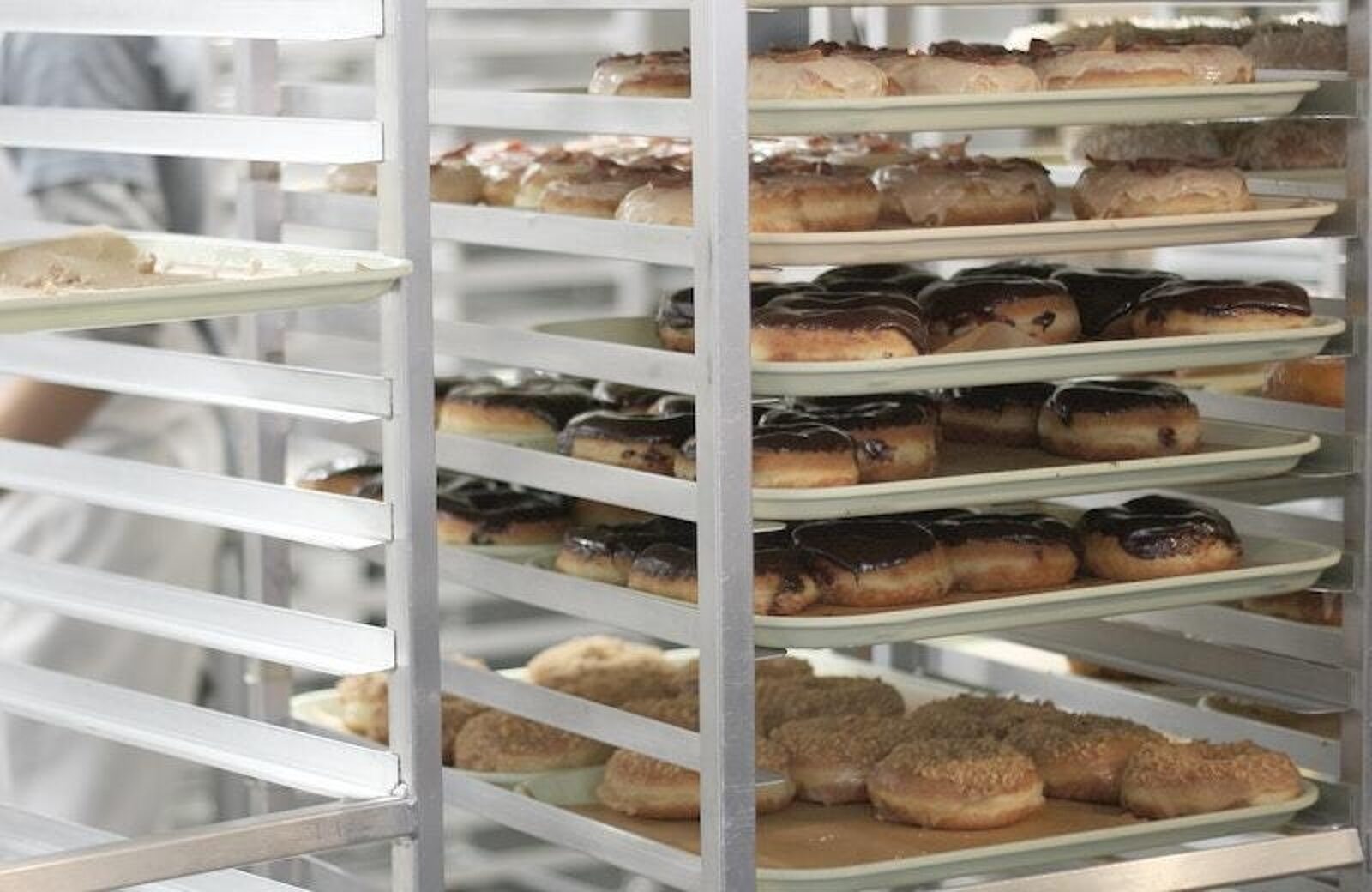
How Much Do Donut Shops Make?
Learn how to optimize your donut shop’s revenue and improve profit margins.

Caroline PriceAuthor


Opening a Donut Shop Checklist
So many things go into opening a donut shop. With this free PDF checklist, you'll set your new business up for success.
Get free downloadOpening a donut shop can be a rewarding venture, but understanding the revenue potential is crucial for long-term success. On average, a donut shop in the U.S. can generate monthly revenues ranging from $8,000 to $42,000, depending on various factors like location, size, and market competition. This translates to an annual revenue range of approximately $100,000 to $500,000, or more, for successful shops. According to Fortune Business Insights, the global donuts (doughnuts) market size was valued at USD 10.84 billion in 2023 and is projected to grow from USD 11.22 billion in 2024 to USD 15.12 billion by 2032, exhibiting a CAGR of 3.79% during the forecast period.
However, the key to maximizing your donut shop’s revenue and ensuring long-term viability lies in optimizing various aspects of your business. This includes everything from selecting a high-traffic location and offering a diverse menu to leveraging digital marketing strategies and providing exceptional customer service. Focusing on these areas gives your donut shop the best chance to thrive in a competitive market.
Revenue and Profit Margins for Different Types of Donut Shops
Are Donut Shops Profitable?
Donut shops can be profitable, typically operating with profit margins between 5% and 20%. Profitability hinges on effectively managing costs.
Known in Los Angeles for their iconic giant rooftop donut, Randy’s Donuts has grown from a mom and pop shop into a global franchise. Owner Mark Kelegian shared with Los Angeles Magazine, “... Internationally, we have 69 stores in development. We’re opening our fourth store in Korea this month, and soon we’ll be in Jeddah, France, and Morocco. We’re working with large players in China. We haven’t struck a deal yet but they’re particularly fond of sweets.”
Whether you plan to open one store or many, when researching the revenue potential of a donut shop, it's important to recognize that the income can vary significantly based on the type of shop, location, and operational model. Here’s a breakdown of the revenue ranges and expected profit margins for different types of donut shops:
Traditional Brick-and-Mortar Donut Shop
Monthly Revenue: $8,000 to $42,000
Traditional donut shops with a good location and strong customer base can earn anywhere from $8,000 to $42,000 per month. These figures are influenced by factors such as the shop's location, foot traffic, and the range of products offered.
Profit Margin: 10% to 20%
For traditional shops, profit margins typically range from 10% to 20%, depending on how efficiently the business is managed and how well costs are controlled. This means that on a monthly revenue of $42,000, a shop could net between $4,200 and $8,400 in profit.
Franchise Donut Shop
Monthly Revenue: $20,000 to $80,000
Franchise donut shops (e.g., Dunkin' Donuts, Krispy Kreme) typically generate higher revenues due to brand recognition and established customer loyalty. Monthly revenues can range from $20,000 to $80,000, depending on the franchise and location.
Profit Margin: 5% to 15%
While franchises benefit from brand strength, they also come with higher overhead costs and royalties, which can reduce profit margins to between 5% and 15%. Thus, on a revenue of $80,000, a franchise owner might expect a net profit of $4,000 to $12,000.
Specialty or Gourmet Donut Shop
Monthly Revenue: $10,000 to $70,000
Specialty or gourmet donut shops that offer unique flavors and premium ingredients can command higher prices and, in some cases, achieve monthly revenues between $10,000 and $70,000. These shops often attract a niche but loyal customer base.
Profit Margin: 15% to 25%
Due to their ability to charge premium prices, specialty donut shops can enjoy higher profit margins, typically ranging from 15% to 25%. For example, a $70,000 monthly revenue translates to a profit between $10,500 and $17,500.
Donut Food Truck
Monthly Revenue: $5,000 to $15,000
Donut food trucks offer flexibility and lower overhead costs, but they also typically generate lower revenues than brick-and-mortar locations. Monthly earnings for donut food trucks generally range from $5,000 to $15,000.
Profit Margin: 20% to 30%
Food trucks often enjoy higher profit margins due to lower fixed costs. These margins can range from 20% to 30%, meaning a food truck could see profits of $1,000 to $4,500 on $15,000 in revenue.
Expected Profit Margins
With profit margins typically ranging from 5% to 20%, most donut shops can achieve a solid return on investment, especially when they effectively manage costs and attract a steady customer base. Lower margins are more common in franchised businesses due to franchise fees and royalties, while independent and mobile businesses can achieve higher margins due to lower overhead costs.
Where to Optimize Costs
To improve profit margins, it's crucial to focus on optimizing both fixed and variable costs. Fixed costs are expenses that remain relatively constant regardless of sales volume (e.g., rent, utilities, insurance, marketing). Variable costs fluctuate based on the volume of sales (e.g., ingredients, labor, supplies). Keeping those costs in mind, here are seven areas where costs can be managed more effectively:
1. Ingredients:
Cost: $2,000 - $6,000/month (10-15% of revenue)
Optimization: Buy in bulk, reduce waste, and negotiate with suppliers.
2. Labor:
Cost: $5,000 - $15,000/month (20-35% of revenue)
Optimization: Optimize staffing, cross-train employees, and adjust schedules.
3. Rent/Lease:
Cost: $1,000 - $5,000/month (5-10% of revenue)
Optimization: Choose cost-effective locations, and negotiate leases.
4. Utilities:
Cost: $500 - $2,000/month (2-4% of revenue)
Optimization: Use energy-efficient equipment.
5. Marketing:
Cost: $500 - $3,000/month (1-5% of revenue)
Optimization: Focus on digital marketing like social media.
6. Supplies:
Cost: $300 - $1,000/month (1-3% of revenue)
Optimization: Buy in bulk and negotiate prices.
7. Insurance and Licenses:
Cost: $200 - $800/month (1-2% of revenue)
Optimization: Compare rates to find the best deals.
Opening a Donut Shop Checklist
So many things go into opening a donut shop. With this free PDF checklist, you'll set your new business up for success.

Strategies for Donut Shop Revenue Growth
To ensure your donut shop thrives, focus on strategies that enhance revenue and foster growth:
Improve Marketing Effectiveness
Showcase Your Unique Offerings on Social Media: Social media platforms like Instagram, Facebook, and TikTok are perfect for showcasing the vibrant colors and creative flavors of your donuts. Share behind-the-scenes content, customer stories, and new flavor launches. Engaging posts, combined with targeted ads, can significantly increase your shop's visibility and attract local followers.
Collaborate with Local Businesses and Events: Partner with nearby cafes, restaurants, or food trucks to create unique cross-promotional offers. For example, pair your donuts with a local coffee shop’s seasonal drinks for an exclusive treat. Sponsor community events like local fairs, school functions, or charity fundraisers, where you can offer samples and special discounts to drive traffic back to your shop.
Build a Loyalty Program Tailored to Your Customers: Develop a loyalty program that rewards frequent visitors. Offer a free donut after a certain number of purchases, or give loyal customers early access to new flavors. This not only encourages repeat visits but also fosters a deeper connection with your customers, making them ambassadors for your brand.
The Salty Donut uses social media creatively to connect with its 349k Instagram followers.
Enhance Productivity and Efficiency with Technology
Invest in a Donut-Specific POS System: A modern, donut-focused restaurant POS system can streamline operations by efficiently managing flavors, tracking seasonal demand, and handling complex orders like vegan or gluten-free options. This reduces wait times during busy periods and enhances the customer experience.
Expand with Online Ordering and Delivery: Launch an online ordering system through your website or partner with delivery apps like DoorDash or Uber Eats. Offering delivery, especially during the summer or on weekends, can tap into new customer segments, like families or office workers who prefer to enjoy your treats at home or work.
Utilize Data Analytics for Inventory and Sales: Use data analytics to understand which flavors are most popular, which times of day are busiest, and which promotions drive the most sales. This data can help you manage inventory, schedule staff more effectively, and plan successful promotions, ensuring that your shop operates at peak efficiency.
Increase Average Order Value
Introduce Gourmet or Seasonal Donut Offerings: Offer premium options such as gourmet or seasonal donuts that cater to decadent or adventurous customers. These higher-priced items can attract customers willing to spend more for quality and uniqueness, boosting your profit margins.
Create Tempting Combos and Upsell or Cross-Sell: Develop combo deals that include a dozen donuts and a box of coffee. Encourage staff to upsell by suggesting seasonal or limited-edition donuts or “Buy three, get one free” promotions, or custom orders, which can significantly increase the average sale.
Offer Branded Merchandise and Take-Home Items: Sell branded merchandise, such as T-shirts, stickers, hats, or tote bags with your logo. Offer take-home products like donut box bundles or DIY fry-at-home donut kits, which not only increase sales but also keep your brand top of mind when customers enjoy your products at home.
Founded in Evansville, Indiana in 2019, Parlor Doughnuts has rapidly gained popularity, expanding into franchises across 19 states. With a growing fan base, they now offer a variety of branded merchandise."
Increase Customer Purchase Frequency
Run Seasonal Flavor Promotions: Keep customers coming back by regularly introducing limited-time flavors that reflect the season—like white chocolate peppermint in winter or margarita in the summer. Promote these flavors through email newsletters and social media to create excitement and urgency.
Launch a Subscription Program for Donut Enthusiasts: Offer a subscription service where members receive a monthly delivery of exclusive flavors, special discounts or freebies, or early access to new products. This not only generates consistent revenue but also deepens customer loyalty.
Engage with the Local Community through Events: Host events, donut and coffee socials, or flavor creation contests. Participating in local farmers’ markets or street fairs can also boost your visibility. These activities create memorable experiences that encourage customers to visit more frequently and bring their friends along.
Maui, Hawaii’s The Madame Donut engages with her community through social media and updates her followers about events such as her on-the-road donut pop-up tour in California.
Final Thoughts
To grow your donut shop into a thriving, profitable business, it’s crucial to implement these specific, donut-focused strategies. By enhancing your marketing, leveraging technology to improve efficiency, increasing average order values with premium products, and encouraging repeat visits through community engagement and loyalty programs, you can significantly boost your revenue and ensure long-term success in the competitive donut market. Balancing innovation with a deep understanding of your customers' preferences will help your shop stand out and prosper.
Is this article helpful?
DISCLAIMER: This information is provided for general informational purposes only, and publication does not constitute an endorsement. Toast does not warrant the accuracy or completeness of any information, text, graphics, links, or other items contained within this content. Toast does not guarantee you will achieve any specific results if you follow any advice herein. It may be advisable for you to consult with a professional such as a lawyer, accountant, or business advisor for advice specific to your situation.
Read More
Subscribe to On the Line
Sign up to get industry intel, advice, tools, and honest takes from real people tackling their restaurants’ greatest challenges.



